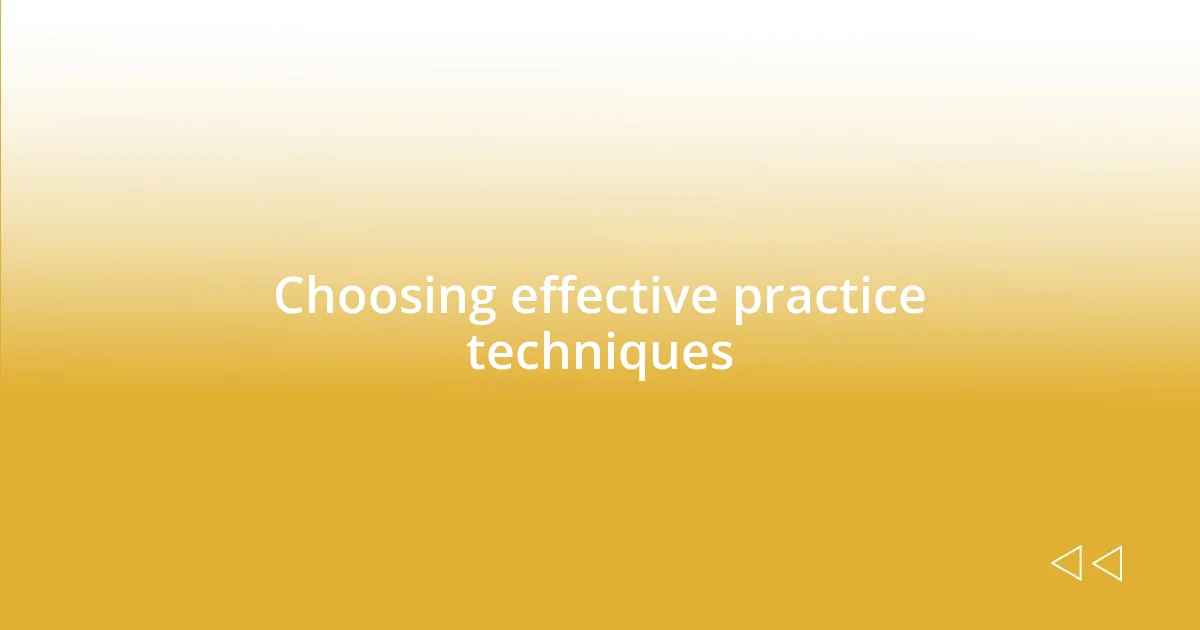Key takeaways:
- Setting specific, dual-focused goals (process and outcome) enhances motivation and guides practice effectively.
- Incorporating feedback through self-recording and external perspectives accelerates skill improvement and clarifies areas needing attention.
- Maintaining motivation involves varying practice techniques and environments, and recognizing small achievements helps combat self-doubt and fosters consistency.

Understanding practice routine goals
Setting goals for your practice routine is like creating a roadmap for your journey. I remember when I first structured my practice around specific outcomes; instead of just playing aimlessly, I felt a renewed sense of purpose. Have you ever noticed how having a clear target can ignite your motivation?
Another essential aspect to consider is the type of goals you choose. I prefer focusing on both process-oriented goals—like mastering a technique—and outcome goals, such as performing confidently in front of an audience. This dual approach not only keeps my practice varied but also helps me stay emotionally invested. What about you? Do you lean more toward one type of goal over the other?
It’s also important to reflect on your long-term vision. I once set a lofty goal to perform at a local venue, which guided my practice sessions for months. Thinking about where you want to be in the future can significantly shape the effectiveness of your routine. How do you envision your skills evolving? That clarity can drive your daily practice decisions and ultimately lead to greater fulfillment.

Establishing a practice schedule
When I established my practice schedule, I found that consistency was key. I began by dissecting my week into chunks, blocking off specific times for practice. This structured approach not only made my practice more reliable but also gave me something to look forward to each day. I’ve noticed that when I skip a session, it disrupts my flow and motivation.
To effectively set up a practice schedule, consider the following points:
- Identify Your Best Time: Reflect on when you’re most alert and focused. For me, early mornings work wonders.
- Consistent Duration: Stick to a certain period, perhaps 30 minutes to an hour, to maintain a routine without feeling overwhelmed.
- Flexibility Is Important: Allow yourself to adjust your schedule as needed, embracing spontaneity when it enhances your creativity.
- Incorporate Variety: Allocate different days to focus on various skills or techniques to keep things fresh and exciting.
- Track Your Progress: Keep a journal or use apps to monitor your sessions—this visually reinforces your dedication and growth.
Once I started this practice framework, I realized how crucial it was for my development. Not only did I become more disciplined, but I also began to enjoy each session more deeply, transforming practice into a rewarding part of my daily life. What I learned was that the rhythm of my routine often mirrored my emotional state, which made sticking to my schedule not just beneficial but essential for my well-being.

Choosing effective practice techniques
When it comes to choosing effective practice techniques, I find it vital to explore various methods. In my journey, for instance, I experimented with deliberate practice—a technique that demands focus on specific areas of improvement. The moment I shifted my focus from simply “playing through” to pinpointing mistakes and relentlessly refining them, my skills skyrocketed. Have you thought about how targeting your weaknesses could transform your proficiency?
I also cherish utilizing varied practice techniques to stay engaged. Recently, I adopted visualization exercises; picturing completing a piece flawlessly not only alleviated my anxiety but also enhanced my performance. It’s fascinating how the brain can create neural pathways just through mental rehearsals, almost as if I’m practicing without the instrument in hand! Do you mix up your techniques, or do you find comfort in a routine?
Another insight I’ve gathered is the impact of incorporating feedback into practice. Recording myself and analyzing the playback was a game changer for my performance. The immediate reactions I noted from watching my recordings helped clarify what needed improvement, which was often different from what I perceived in the moment. Have you ever recorded your sessions? It can feel daunting, but it’s an incredible tool for growth.
| Technique | Description |
|---|---|
| Deliberate Practice | Focuses on identifying weaknesses and refining them deliberately for improvement. |
| Visualization | Mental rehearsals that enhance performance by forming neural pathways. |
| Feedback Analysis | Recording performances to analyze strengths and weaknesses for better progress. |

Incorporating feedback into practice
Incorporating feedback into my practice has been a transformative experience. I still vividly remember the first time I recorded one of my sessions. Watching myself play, I was surprised at the discrepancies between how I felt I sounded versus the actual output. It was eye-opening! This realization prompted me to use a checklist after each recording, focusing on specific elements I could improve. Have you ever experienced that shocking contrast between expectation and reality? It can spark incredible growth!
Another powerful method I’ve used is seeking feedback from trusted friends and mentors. Their perspectives often shine a light on areas I might overlook in the heat of practice. One of my friends, who has a great ear, once pointed out a recurring rhythm mistake that I had dismissed as negligible. Once I addressed it, my entire piece felt more cohesive. Isn’t it amazing how external insights can help refine our skills?
Lastly, I find that integrating feedback into my routine isn’t just about addressing flaws—it’s also about acknowledging what I do well. I set aside time in my practice sessions solely for celebrating my strengths. After all, recognizing progress can provide a motivational boost. How do you celebrate your achievements in practice? Celebrating small wins fosters a positive mindset and encourages me to keep pushing forward.

Tracking progress and adjustments
Tracking my progress has become a cornerstone of my practice routine. I often keep a journal to document my sessions—after each practice, I jot down what went well and what didn’t. There’s something incredibly satisfying about flipping back through those pages and seeing my evolution over time. Have you tried journaling your practice? It can truly be enlightening!
Adjustments come easily when I have a clear record to refer to. For instance, after noticing a consistent struggle with a particular passage, I decided to revisit it with a fresh approach—breaking it down into smaller sections. Each small victory gives me a rush of motivation, reinforcing my determination to tackle the next challenge. This adaptability not only keeps my practice dynamic but also ensures I’m addressing my weaknesses head-on. Have you ever adapted your routine based on what you’ve tracked? It can be a game changer!
Reflecting on my progress isn’t just about technique; it also involves emotional growth. Recently, I realized I was feeling more anxious before performances. Tracking those feelings helped me see the patterns—typically linked to certain pieces or situations. By addressing this anxiety through specific breathing exercises and more mindful practice, I noticed a significant change in my overall confidence. How do you handle emotional hurdles in your practice? Recognizing these mental blocks can be just as important as refining our musical skills.

Overcoming common practice challenges
Common practice challenges can be daunting, but I’ve learned that a shift in perspective can make all the difference. For example, I used to dread long, monotonous practice sessions. However, when I started breaking them into shorter, focused bursts, I found I was much more engaged. Have you ever experienced a shift like that? It’s incredible how rethinking our approach can spark renewed enthusiasm.
Another significant hurdle I faced was maintaining consistency, especially during busy weeks. I remember a period when I barely picked up my instrument. It felt overwhelming to jump back in after a break. That’s when I established a quick warm-up routine. Just spending ten minutes a day kept me connected to my practice. Have you tried bite-sized practice sessions during hectic times? They can help bridge the gap between sessions.
Finally, I often grapple with feelings of self-doubt, especially when trying new techniques. It’s easy to get discouraged and think, “Am I ever going to get this right?” To combat this, I set realistic milestones, celebrating small accomplishments along the way. Just last month, I finally nailed a challenging piece after weeks of effort. That sense of achievement was worth every struggle. How do you manage self-doubt in your practice journey? Finding those little victories can be such a powerful motivator!

Maintaining motivation and consistency
Staying motivated and consistent in practice is a constant balancing act for me. I’ve found that setting specific, tangible goals is crucial. For example, when I set out to master a particularly tricky scale, I make it a point to take note of my progress each week. This tangible goal creates a sense of purpose that keeps me up to date with my routine. Have you ever noticed how a clear target can reignite your commitment?
It’s not just about the goals, though; the environment plays a significant role in maintaining my motivation. I remember one time, I switched my practice location from a quiet room to my sunlit garden. That change in scenery transformed my mindset, making me look forward to practicing rather than viewing it as a chore. What kind of space do you practice in? Sometimes, just a little shift can make the world of difference.
Another aspect I’ve found essential is incorporating variety in my sessions. When I first started practicing, I stuck to a rigid schedule and eventually burned out. Now, I mix it up—one day it might be scales, the next improvisation, or tackling a new piece I’m curious about. Learning becomes a fun exploration rather than a monotonous duty. Have you tried mixing things up in your practice? You might be surprised how much it reinvigorates your love for your craft.















